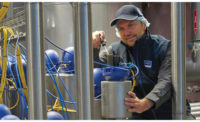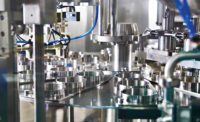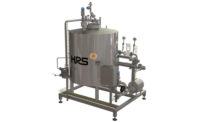Heat exchanger systems enable dairy plants to effectively heat and cool their products without fouling them. Those in the market for a new heat exchanger system need to consider factors such as processing efficiency, ease of maintenance and cleaning, and cost-efficiency, while avoiding heating that ramps up too quickly, damaging heat-sensitive liquids and adding to cleaning frequency. Plate thickness, corrugation and gaps within the heat exchanger are also important considerations.
Plenty to consider
Operators may choose from three different types of heat exchangers, typically based on the mix of products they have in mind. Dairy plants most often use plate heat exchangers, noted Anders Nelson, design engineer at O’Brien & Gere, Syracuse, N.Y., a systems integrator and certified member of the Control System Integrators Association (CSIA). For ice cream mixes, eggnog and other viscous products, a tubular heat exchanger might make more sense, he added, while yogurt is probably the only dairy product that would use a scrape surface exchanger.
Dairy plants next need to consider the process parameters so they can hit the right temperature progression and flow rate, Nelson said. They also need to evaluate unexpected conditions such as potential changes in product or other adaptations that might be needed.
In selecting a heat exchanger, dairy plants also need to take into account their application and operational goals to be able to maximize heat recovery, reduce cleaning times, lower maintenance overhead and provide reliable, consistent results, said Uday Shastri, senior technical specialist, APV Heat Exchanger, for SPX Flow, Charlotte, N.C. Frame selection will depend on the plant’s size, automation needs, cleaning frequency and time between batches.
GEA Heat Exchangers, Bochum, Germany, sees temperature, product type and viscosity as other key features to consider when selecting a heat exchanger, said Nathan Allen, director, dairy solutions sales, North America.
“Mistakes can happen during selection, specifically when there is a lack of information regarding the products to be treated,” he said.
For its part, Tetra Pak, Denton, Texas, asks for a list of products, both current and potential future offerings, to determine which of the three types of heat exchangers would work best, said Don Bohner, product manager for heat exchangers.
“A lot of what goes into designing a heat exchanger is the viscosity of the product they want processed,” he said. “Do they plan on future expansion? We can design the unit large enough to accommodate that additional capacity down the road.”
Given such changes over time, dairy plants shouldn’t simply purchase the same type of heat exchanger they’ve had before, noted George Adams, director of sales, AGC Heat Transfer Inc., Bristow, Va. The company does free rheology testing to determine how a given product would perform in a given type of exchanger.
“It gives them peace of mind,” he said. “CIP (clean in place) is the other big area we try to work with people on, so they understand what’s required.”
In addition to matching the heat exchanger to the viscosity of product, Alfa Laval, Lund, Sweden, encourages customers to consider factors such as flow rate and cleanability, said Melissa Fryer, sanitary heat transfer business development manager.
“A lot of times, customers will give us a flow rate that’s higher than what they’re going to run, feeling that more is better. And that’s not always the case,” she said.
HRS Heat Exchangers, Hertfordshire, England, asks about product type, viscosity and flow rates, as well as “how that material behaves, especially when you’re heating or cooling it,” said Matt Hale, international sales and marketing director. “The most common mistake is that people don’t know what their products contain, and they don’t know the true viscosities.”
Dan Jacoby, automation solutions consultant for St. Louis-based Malisko Engineering, another systems integrator and CSIA-certified member, suggested that dairy plants account for the type of product and the part of the process in which the heat exchanger is being placed, whether that be pre-treatment, pasteurization or something else. Flow rate and viscosity are other factors.
Install and operate correctly
In selecting a heat exchanger, dairy plant operators should also select a partner with experience in supporting both smooth installation and trouble-free operation of such machines, Shastri said.
“Considering units designed for longer run times, along with ease of cleaning and inspection accessibility, can also significantly reduce ongoing maintenance costs,” he said.
When installing a heat exchanger, dairy plants need to ensure the piping is supported properly, too, Bohner said.
“If they’re reliant on the heat exchanger to support a length of pipe, it creates a torque on that connection on the frame,” he said. “From vibrations and weight, it can crack that connection and cause a leak.”
Other considerations Bohner cites include minimizing the risk of hydraulic shocks that can crack plates or the heat transfer surface, minimizing cross-contamination between raw and pasteurized sections, ensuring adequate instrumentation such as pressure and temperature gauges, and ensuring regular cleaning and rinsing.
“Attention has to be given to the city water, and the amount of chlorine or chloride,” he added. “If it’s too high, you can get corrosion on the stainless steel.”
AGC works with customers to simplify the configuration of porting and piping while ensuring that takes into account separated raw and pasteurized sides, Adams said. “We’ve seen some real ‘spaghetti’ porting over the years,” he noted. “We always try to get them to look at their footprint and evaluate future expansion.”
To properly operate and maintain heat exchangers, dairy plants must open them regularly, he added.
Fryer encourages customers to ensure they’re operating within the parameters for which the heat exchanger was sized — the units will fail quicker if pushed past their limits — and then redesign as needs change. She said plate heat exchangers are simple to reconfigure and operate better with highly viscous products than customers sometimes think, although “you can’t take heat exchangers designed for fluid milk and run them for a high-fat ice cream mix.”
Drainability and cleanability are two of the keys Hale cited in terms of best practices in installation and operation, partly for regulatory reasons. A corollary to those factors is easy access for servicing, he said.
“We see a lot of cases where people shoehorn heat exchangers into small areas. … You want to make sure you have a good footprint for access,” he said.
Jacoby recommends that dairy plants consider the surface area they need for product flow and heat transfer. He said a common pitfall is “trying to reuse something that wasn’t specifically designed for that process, instead of sizing it correctly.” Another common mistake is allowing too much fouling to build up, lowering the heat transfer coefficient and leading to a more complicated cleaning regimen when the plant finally does open up the unit.
Aaron Williams, account executive at equipment repair firm Litre Service Inc., Auburn Hills, Mich., also urges dairy plant operators to replace cheaper parts before they wear out and potentially damage more expensive ones.
“If you have out-of-spec scraped blades, they flip over inside the barrel,” he said. “Because you didn’t replace a $60 blade, you’re now going to have to replace a $30,000 cylinder.”
Consider new and improved models
Recently released heat exchanger models include the HRS R Series rotary scraped surface heat exchanger developed for hygienic applications. The unique selling point of the system is the accommodation of a multi-tube heat exchanger into a scrape surface — most accommodate only a single tube, Hale said.
“We have a three-tube or six-tube unit, so you can replace up to two-and-a-half standard units with one of ours,” he said.
HRS touts the R Series as the “ideal” solution for viscous applications, including custards and creams, which otherwise could have problems with fouling or low heat transfer. Other features include a large heat transfer area, reduced pressure drop, high level of product recovery, low-noise-level gearbox and high energy-efficiency, the company said.
Among the newer inclusions within the SPX Flow plate heat exchanger portfolio are frames designed to improve safety and reduce potential damage to the plate from manual operations. The APV Quad-Drive series features hydraulic PLC-driven frames that allow rapid, repeatable quality maintenance, while the Binary-Drive series is PLC-controlled, able to open or close at the touch of a button, and incorporates flexible, scalable control to match the application’s needs.
Dairy applications with more acidic products might want to consider SPX’s DuoSafety plate technology, Shastri said. This features two loose plates fitted together with a nonglued gasket, which provide additional safety against the possibility of through-plate leakage since the liquid will flow between the plate pair to the atmosphere.
For its part, GEA builds customized tubular heat exchangers to a customer’s specifications based on an understanding of product recipes and with constant velocity in mind, Allen said. They can be easily disassembled as needed for inspection, too.
And Tetra Pak has a new tubular heat exchanger available with Product to Product technology that meets 3-A standards and can run raw product on one side and pasteurized on the other, Bohner said. This allows for product-to-product regeneration, unusual in tubular heat exchangers, which enhances heat-recovery efficiency.
“What it means to the customer is lower operating costs,” he said.




